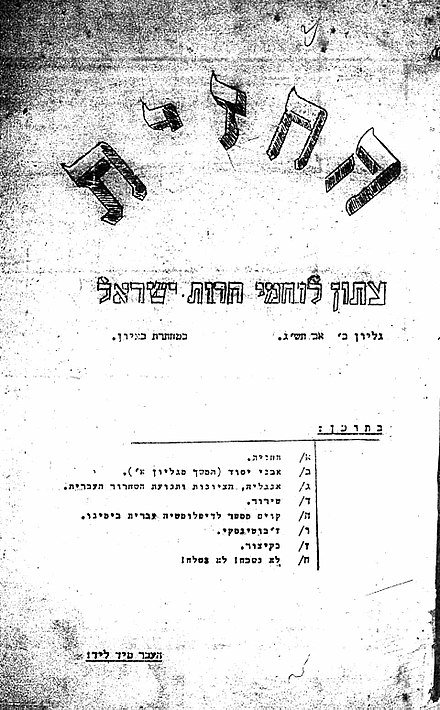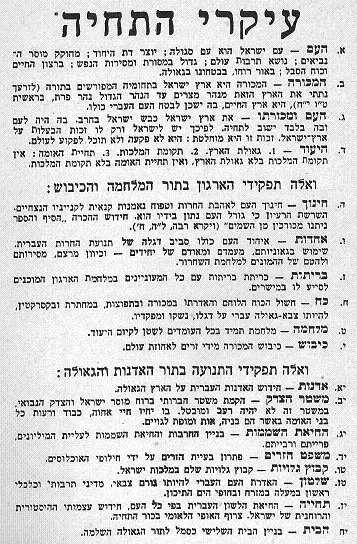Fighters for Israeli Freedom
On May 28, 1948, the Fighters for Israeli Freedom held a ceremony at Sheikh Munis (on the campus of today's Tel Aviv University), during which approximately 700 former Lehi members joined the Israel Defense Forces, most of them assigned to Brigade 8. In the War of Independence, most former Lehi members fought as part of Brigade 8.
However, around 100 former Lehi members operated independently in the Jerusalem area, which remained outside the partition plan and was intended for international status. Joshua Zettler ("Meir") was in charge of Lehi's activities in Jerusalem. As part of Lehi's activities in Jerusalem, the villages of Lifta, Sheikh Badr, and Dir Yassin were captured, and the "Dror" camp was established in Tzrifin.
Some of Lehi's actions in Jerusalem were controversial, including the Dir Yassin massacre, the assassination of the Polish consul Władysław Wolski, and the assassination of UN mediator Folke Bernadotte. Following the assassination of Bernadotte, the Israeli government ordered the dissolution of Lehi.
The Fighters for Israeli Freedom, known by the acronym "Lehi" (or "Lohamei Herut Yisrael" in Hebrew), was a Hebrew underground organization in the land of Israel that operated against British Mandate rule from 1940 until the establishment of the State of Israel in 1948.
Designated as a terrorist organization by the British Mandate government and, subsequently, the provisional Israeli government following the assassination of Lord Moyne, Lehi was founded by dissidents from the National Military Organization (Irgun) who opposed suspending the struggle against the British Mandate during World War II.
Formation and Early Actions:
In their operations, Lehi members sought to target senior British government officials and military personnel through assassinations and attacks on strategic facilities. In 1940, during the Holocaust, the organization attempted to negotiate a deal with Nazi Germany to save European Jews from extermination and facilitate their immigration to the Land of Israel. In exchange, Lehi pledged to wage war against the British Empire from within the borders of Israel.
Recognition and Transformation:
In 1980, the State of Israel officially recognized the contribution of Lehi and acknowledged it as a group that had played a role in the establishment of the state. That same year, the "Lehi Ribbon" was established and awarded to former members of the organization.
Split from the Irgun:
At the outbreak of World War II on September 1, 1939, most of the leaders of the Irgun found themselves in British custody, having been arrested four days after the publication of the White Paper in May 1939. The leadership of the Yishuv (Jewish community in Palestine) called for cooperation with the British in their war against Germany.
Many members of the Yishuv joined the British army and assisted the British war effort. The Revisionist Zionist movement, however, also endorsed participation in the war against the Nazis. In September 1939, David Raziel, who was in custody at the time, ordered a halt to the Irgun's offensive actions against the British in order not to hinder the war effort against Germany and to dedicate maximum forces to assisting England as its ally.
Raziel's declaration led to a significant internal struggle within the Irgun. Abraham Stern, known as "Yair," emerged as the leader of the faction opposed to Raziel's directive. After Raziel was released from prison in October 1939, and the other members of the Irgun's leadership were released in June 1940, open confrontation between Raziel and Stern ensued, leading to a definitive split within the Irgun.
After Ze'ev Jabotinsky was forced to clarify the identity of the Irgun's leader to the British authorities through letters from the United States, the splinter group that broke away eventually adopted the name "National Military Organization in Israel" initially, distinguishing itself from the "National Military Organization in the Land of Israel" from which they had seceded. Later, in 1943, after the assassination of Abraham (Yair) Stern, the group changed its name to "Fighters for Israeli Freedom."
Leadership and Activities:
Abraham Stern served as the head of the underground until he was captured and assassinated by British intelligence officer Geoffrey Morton on February 12, 1942, at his hideout in Tel Aviv. After his death, a new leadership emerged, including Yitzhak Shamir (then known as Yitzhak Yezernitzky or Michael), Israel Eldad (pen name: Eldad), and Nathan Friedman-Yellin (pen name: Gra). Other prominent members included Joshua Zettler, Yitzhak Hasson, Yaakov Eliav, Yaakov Grinik, Geula Cohen, Joshua Cohen, Boaz Evron, and Amos Kenan.
Lehi was a relatively small organization, numbering only a few hundred members, but it carried out audacious actions against the British authorities. These actions included setting traps for British policemen and attacking British targets. The British derogatorily referred to the organization as "The Stern Gang" or "Jamiat Stern" in Arabic, attempting to diminish its significance as a resistance group.
Lehi occasionally resorted to bank robberies to fund its activities. The organization also published a weekly newsletter called "HaMa'as" and operated an underground radio station, "Kol HaMachteret HaIvrit," with Geula Cohen as its announcer and technical support provided by Yaakov Yitzhaki (Alex). Many members joined Lehi through the religious youth movement "Brit HaChashmonaim."
Formation of the Religious Division:
Shortly after Lehi's establishment, the "Religious Division of Lehi" was formed in Jerusalem. This division was intended for the ultra-Orthodox and religious members of Jerusalem who wished to join Lehi. Isaac Gavri, who also served as the division's leader, was the chief figure in this division. He was also the chief rabbi for Lehi in Jerusalem.
Relationship with Haganah:
The members of the Haganah, another Jewish paramilitary organization, regarded Lehi and the Irgun as splinter groups that operated against the directives of the national institutions. However, during the "Saison" (the period of internal confrontation within the Jewish resistance organizations), they refrained from targeting Lehi members.
After the end of World War II on November 1, 1945, Lehi joined the Jewish Resistance Movement, which united all the resistance forces in the Mandate territories. Despite the formal cessation of hostilities by the Jewish Resistance Movement, Lehi and the Irgun continued their struggle even after it dissolved, expanding their activities beyond the borders of the Land of Israel.
- לוחמי חרות ישראלhe.wikipedia.org














